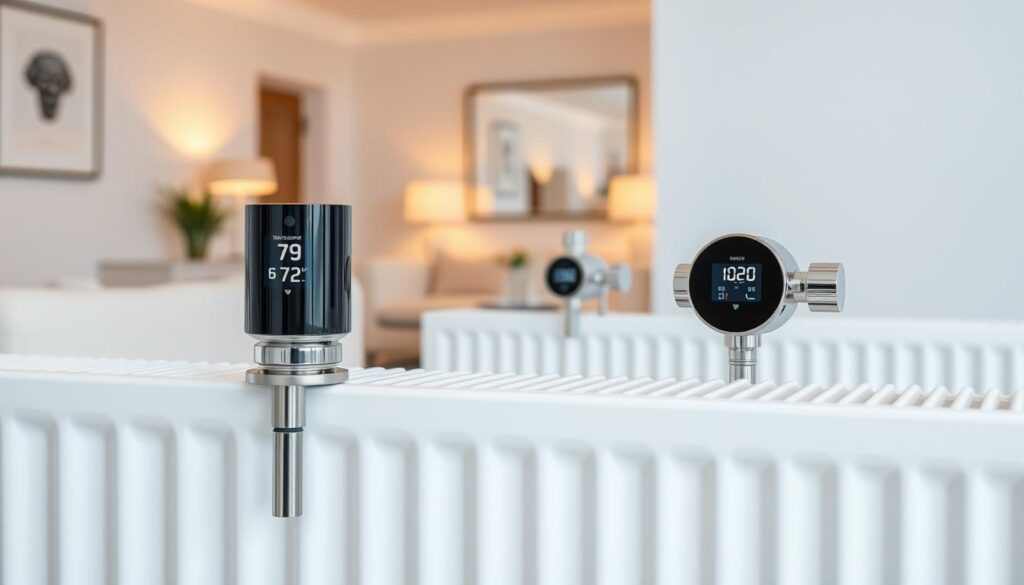Are you tired of wasting energy and money on inefficient heating systems? As a homeowner in the UK, you’re likely looking for ways to optimise your home’s heating while reducing your energy bills.
Smart Thermostatic Radiator Valves (TRVs) represent a significant evolution in home heating control technology, allowing you to regulate the temperature in your home with precision.
This comprehensive buying guide is designed to help you make informed decisions when selecting the right TRVs for your specific home setup, covering everything from basic functionality to advanced features and compatibility considerations.
By upgrading to smart TRVs, you can enjoy significant energy efficiency benefits and cost savings, ensuring your central heating system operates optimally.
Key Takeaways
- Understand the benefits of smart TRVs in modern home heating systems.
- Learn how to choose the right TRVs for your home.
- Discover how smart TRVs can help you comply with the UK’s Boiler Plus requirements.
- Find out how to optimise your heating system’s energy efficiency.
- Explore the cost savings potential of smart TRVs.
What Are Smart Thermostatic Radiator Valves?
As we move towards smarter homes, the role of smart thermostatic radiator valves becomes increasingly important in enhancing our heating systems’ efficiency and effectiveness. You can now control the temperature of individual radiators with greater precision, thanks to these innovative devices.
How Traditional TRVs Work
Traditional thermostatic radiator valves (TRVs) have been used for decades to control the temperature of individual radiators. They work by using a valve to regulate the flow of hot water into the radiator. The valve head expands when it’s cold and contracts when the room is hot, thus controlling the temperature. Typically, TRVs are numbered from 1 to 5, with 1 being the lowest temperature setting and 5 being the highest.
| TRV Setting | Approximate Temperature |
|---|---|
| 1 | Lowest temperature |
| 2 | About 18°C |
| 4 | About 24°C |
| 5 | Highest temperature |
The Smart Evolution: Features and Functionality
Smart TRVs represent the next evolution in radiator control technology, offering advanced features beyond traditional TRVs. These include remote control capabilities via smartphones, scheduling, and integration with other smart home systems. Smart TRVs communicate with central heating systems and smart thermostats to provide more precise temperature control. With their enhanced responsiveness and accuracy, smart TRVs offer a more efficient and convenient heating solution.
Benefits of Installing Smart TRVs in Your Home
By integrating smart TRVs into your home, you can enjoy a more efficient and cost-effective heating solution. Smart TRVs provide you with the control to get the perfect temperature in every room, which is particularly useful as different rooms have different heating requirements.

Energy Efficiency and Cost Savings
One of the primary benefits of smart TRVs is their ability to enhance energy efficiency and reduce heating bills. By only heating rooms when and to the extent needed, smart TRVs can significantly cut down on energy waste. This not only reduces your carbon footprint but also leads to substantial cost savings over time.
Room-by-Room Temperature Control
Smart TRVs allow for customized heating schedules that align with your household’s routine and occupancy patterns. You can control the temperature in each room individually, ensuring that your living areas are warm and comfortable while your bedrooms are cooler, or vice versa, depending on your preferences.
Remote Control via Smartphone
The convenience of controlling your heating system remotely via smartphone apps is a significant advantage of smart TRVs. With remote access, you can adjust your heating on the go, respond to unexpected schedule changes, or warm up your house before arriving home. Additionally, smartphone integration provides valuable data on your heating patterns and energy usage, helping you make more informed decisions about your energy consumption.
As “energy efficiency is becoming increasingly important”, smart TRVs offer a practical solution for UK homeowners looking to modernize their heating systems. By providing room-by-room temperature control, remote access, and valuable insights into energy usage, smart TRVs make a worthwhile investment for those seeking to enhance their home’s comfort and efficiency.
Types of Thermostatic Radiator Valves Explained
Understanding the different types of thermostatic radiator valves (TRVs) is crucial for making an informed decision when upgrading your heating system. Thermostatic radiator valves are not all created equal, and the type you choose can significantly impact your home’s heating efficiency and overall comfort.
Standard TRVs vs Smart TRVs
Standard TRVs and smart TRVs differ significantly in terms of functionality and price. Standard TRVs, which cost from around £12, require manual adjustment to control the temperature. In contrast, smart TRVs, priced between £40-£60 each, offer remote control capabilities via your smartphone or thermostat. This allows for more precise temperature control and greater convenience. Smart TRVs can also communicate with your thermostat to provide room-by-room heating control, making them a more advanced and efficient option.
Wireless vs Fully Integrated Smart TRVs
When it comes to smart TRVs, there are two main types: wireless and fully integrated. Wireless smart TRVs can be controlled remotely but may not communicate directly with your boiler system. On the other hand, fully integrated smart TRVs form part of a comprehensive smart heating system, offering more seamless control and integration with your boiler and other smart devices. The choice between these two types depends on your specific needs and the complexity of your heating system.
Manual Valves vs Thermostatic Valves
Another important distinction is between manual radiator valves and thermostatic valves. Manual valves function like taps, requiring you to turn them on and off manually as needed. Thermostatic valves, however, automatically regulate the temperature, providing a more consistent and energy-efficient heating solution. While manual valves are simple and straightforward, thermostatic valves offer greater convenience and can help reduce your energy bills.
When selecting a thermostatic radiator valve, it’s also worth considering the different valve types available, such as angled, straight, and corner valves, each designed for specific installation scenarios. By choosing the right type of valve for your needs, you can ensure a more efficient and effective heating system.
Smart Thermostatic Valve Buying Guide: Key Features to Consider
When selecting a smart thermostatic valve, it’s crucial to consider several key features to ensure optimal performance. The right features can enhance the efficiency, convenience, and overall user experience of your smart heating system.
Valve Types and Sizes for UK Homes
The standard radiator pipe size in the UK is 15mm, but sizes can vary when purchasing from abroad. It’s essential to choose a valve that matches your radiator and pipework configuration. TRVs come in various shapes, including angled, straight, and corner valves, to accommodate different installations.
For instance, angled valves are the most common type in UK homes, connecting radiators to the central heating system at a 90-degree angle. Ensuring compatibility between the valve type and your existing plumbing setup is vital for effective heating control.
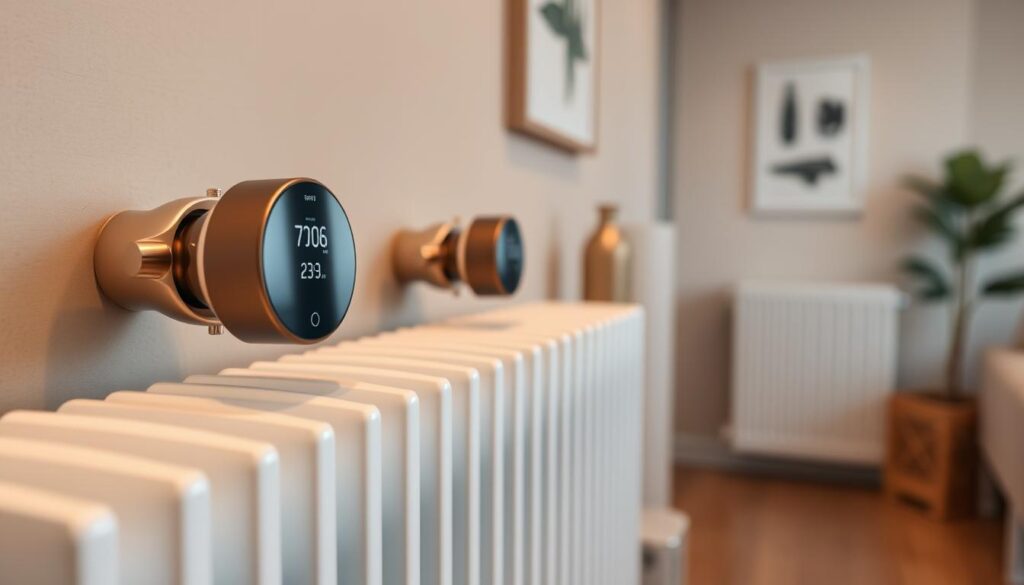
Temperature Range and Frost Protection
Smart TRVs typically offer a temperature range from 0 to 5, corresponding to different room temperatures. Frost protection is a critical feature, as it prevents pipes from freezing during cold periods. Some models also include temperature limitation features to prevent extreme settings, ensuring both safety and efficiency.
Smart Home Integration Capabilities
Many smart TRV models offer integration with popular smart home ecosystems like Google Assistant, Amazon Alexa, and Apple HomeKit. This compatibility allows for seamless control and enhanced functionality. Integration with existing smart thermostats can also provide a more comprehensive heating solution, making it easier to manage your home’s temperature.
When selecting smart TRVs, consider your future smart home expansion plans to ensure long-term compatibility. This forward-thinking approach will help you create a cohesive and efficient smart home system.
Compatibility Considerations Before Purchase
Before purchasing a smart thermostatic radiator valve (TRV), it’s crucial to consider compatibility with your existing heating system. This ensures that your new smart TRV works seamlessly with your radiators and boiler, providing optimal heating control and efficiency.
Radiator Compatibility and Valve Placement
Most smart TRV manufacturers design their products to be compatible with existing radiator valves, making retrofitting relatively straightforward. To retrofit, you typically remove the head of the old TRV and screw on the new smart TRV head, a process that can often be done by the homeowner. However, the placement of the valve is also important. You should consider whether to install the valve at the top or bottom of the radiator, as this can affect performance.
Boiler System Compatibility
Checking boiler system compatibility is vital before purchasing smart TRVs. Different boiler types, such as combi, system, and heat-only boilers, may have varying compatibility requirements. Ensuring that your smart TRV is compatible with your boiler system is crucial for efficient operation. OpenTherm compatibility, for instance, enables more efficient communication between smart controls and compatible boilers.
Boiler Plus Requirements for UK Homes
The UK’s Boiler Plus regulations require an ‘advanced heating measure’ to be fitted with all new combi boiler installations. Smart TRVs can assist compatible controls in achieving better efficiencies. For new combi boiler installations, a combined programmer and thermostat with an ‘advanced’ energy-saving feature is required. Smart TRVs can contribute to meeting energy efficiency standards while providing enhanced heating control.
By considering these compatibility factors, you can ensure that your smart TRV works effectively with your heating system, providing you with optimal comfort and energy efficiency.
Top Recommended Smart TRV Products
In the UK, several smart TRV products have gained popularity for their efficiency, compatibility, and innovative features. When selecting a smart TRV, it’s crucial to consider factors such as compatibility with your boiler system, ease of installation, and additional features like smart home integration.
Boiler Manufacturer Smart TRVs: Vaillant and Worcester
Both Vaillant and Worcester offer their own smart TRVs, designed to work seamlessly with their respective boiler systems. A key advantage of these manufacturer-specific smart TRVs is their use of load compensation, making the combined TRV and smart control setup highly efficient.
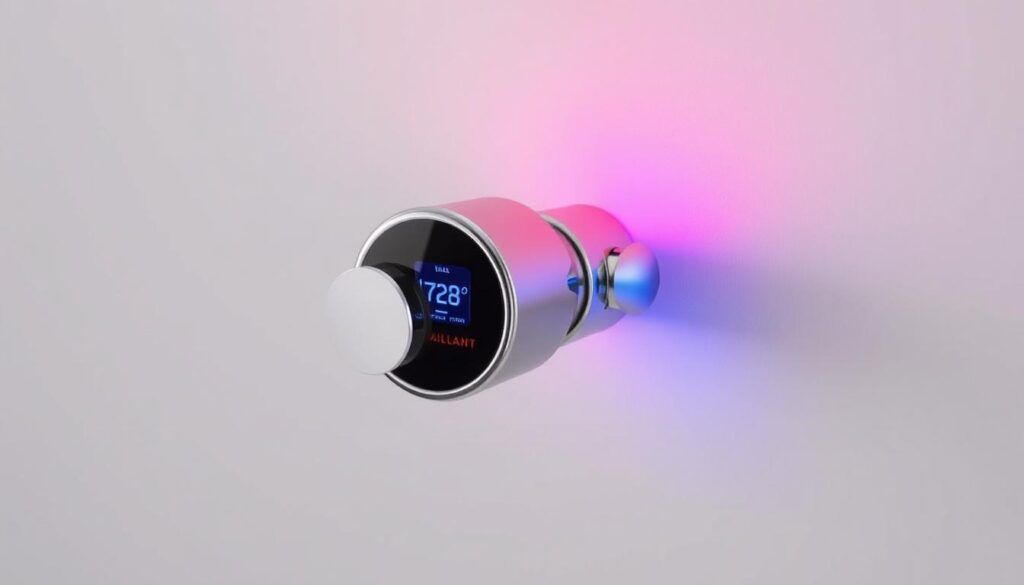
The Vaillant smart TRV is a sophisticated solution that integrates perfectly with Vaillant boilers, offering advanced temperature control and energy efficiency. However, it’s worth noting that these boiler manufacturer’s smart TRVs are generally more expensive and may lack compatibility with popular home automation systems like Alexa or Google Home.

Worcester’s smart TRV also boasts load compensation and is designed to work efficiently with Worcester boilers. One of the significant benefits of choosing Worcester’s smart TRV is the potential for a 10-year guarantee when fitted with a compatible Worcester boiler, providing peace of mind for homeowners.
Third-Party Smart TRVs: Honeywell, Tado, and Nest
For those looking for alternatives to boiler manufacturer smart TRVs, third-party options like Honeywell, Tado, and Nest offer a range of benefits, including greater smart home integration capabilities.
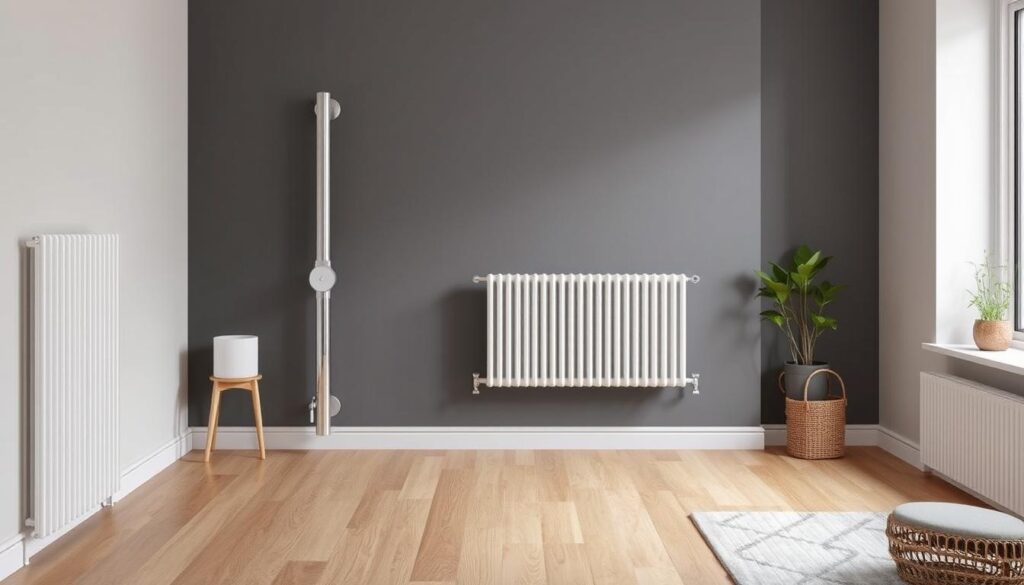
Honeywell’s smart TRVs are known for their reliability and compatibility with various heating systems. They offer advanced features such as geofencing and scheduling, making them a versatile choice for homeowners.
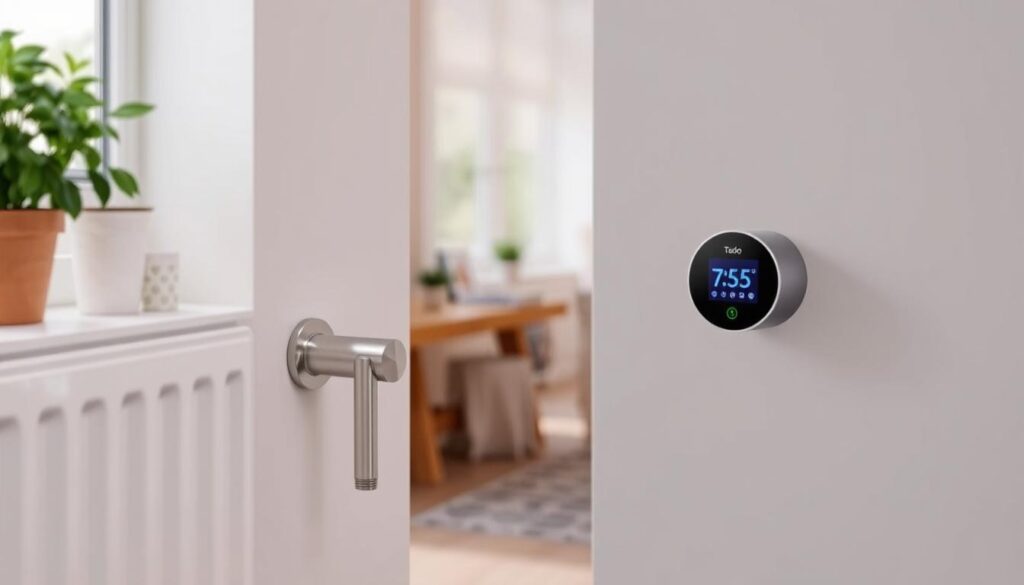
Tado’s smart TRVs are designed with energy efficiency in mind, using OpenTherm protocol to optimise heating performance. Their solutions are also compatible with a wide range of smart home systems.
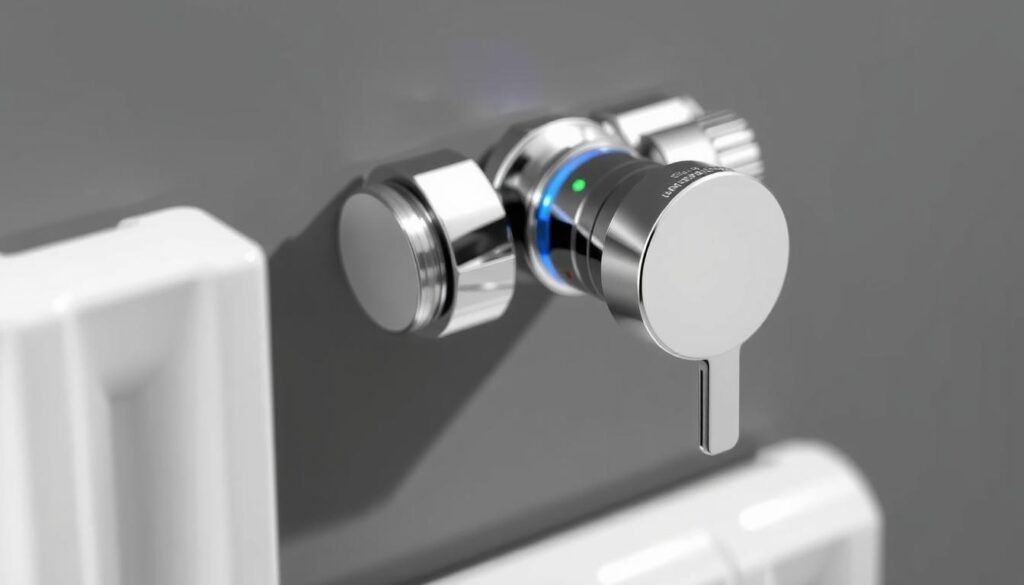
Nest’s smart TRVs offer seamless integration with other Nest products, creating a comprehensive smart home heating solution. Their devices are user-friendly and provide detailed energy consumption reports.
Budget-Friendly Options: Drayton and iBathUK
For homeowners on a budget, Drayton and iBathUK offer affordable smart TRV solutions without compromising on performance.
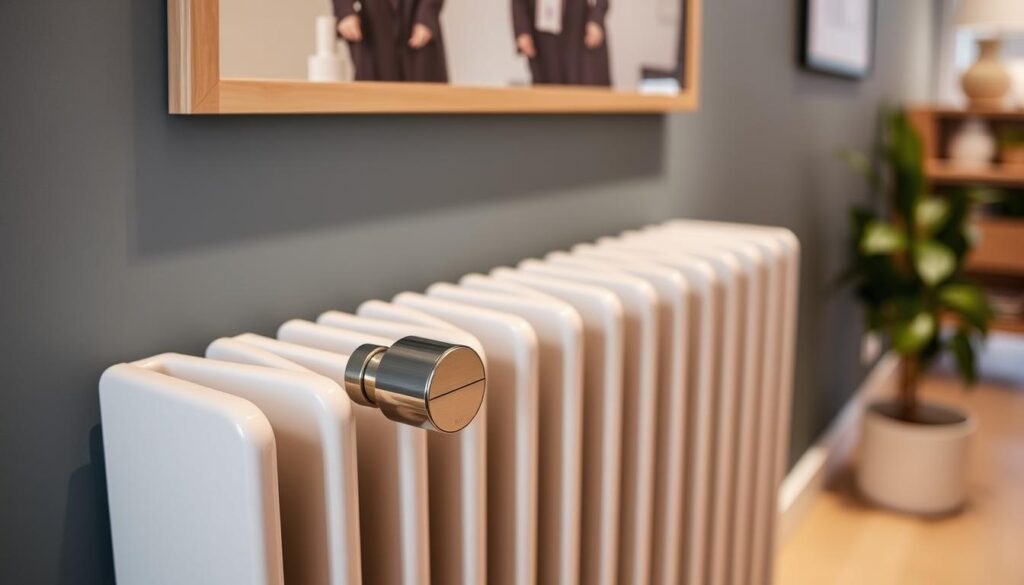
Drayton’s smart TRVs are recommended by the Energy Saving Trust and are rated as Class 1 for efficiency by the European Valve Manufacturers Association. They offer a cost-effective solution for those looking to upgrade their heating system.
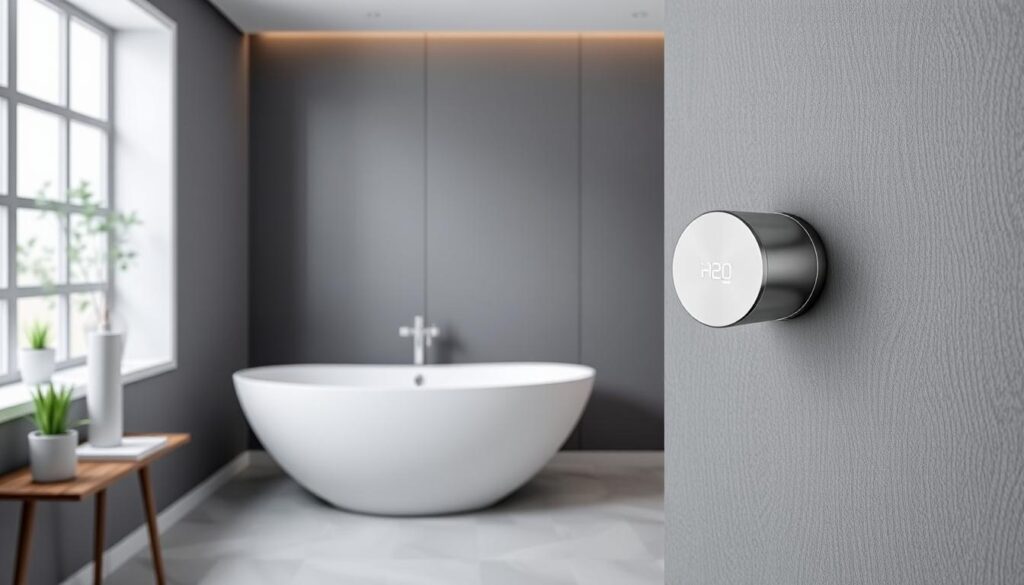
iBathUK’s smart TRVs come with an impressive 10-year guarantee, demonstrating the manufacturer’s confidence in their product. They provide a reliable and efficient heating solution at a competitive price.
When choosing a smart TRV, it’s essential to consider not only the upfront cost but also the potential long-term savings on energy bills. Prices for smart TRVs can vary significantly, ranging from around £50 to over £150 per valve, depending on the brand and features.
Installation and Setup Guidance
Installing smart thermostatic radiator valves (TRVs) can seem daunting, but with the right guidance, it’s a manageable DIY task. You can install smart TRVs yourself, but it’s also possible to hire a heating engineer if you’re not comfortable with DIY projects.
DIY Installation Tips and Considerations
To install smart TRVs, start by removing the old TRV head. You may need to replace the valve insert, as smart TRVs usually come with a new one. Use an adjustable spanner to loosen any stubborn parts. Ensure that you follow the manufacturer’s instructions for specific guidance on installing your particular smart TRV model.
When installing smart TRVs, it’s crucial to consider the compatibility with your existing central heating system. Most smart TRVs work with standard radiator valves, but it’s essential to check the specifications to avoid any issues.
| Installation Step | Description |
|---|---|
| 1. Remove Old TRV Head | Carefully take off the existing TRV head to make way for the new smart TRV. |
| 2. Replace Valve Insert | Insert the new valve insert provided with the smart TRV, ensuring a secure fit. |
| 3. Install Smart TRV | Mount the smart TRV onto the radiator valve, following the manufacturer’s instructions. |
Special Considerations for Bathrooms and Towel Rails
Bathrooms present a unique challenge for TRVs due to the steam from showers and baths, which can cause them to misread temperatures and shut down, even when set to the highest temperature. For bathrooms, consider using manual valves or specially designed bathroom TRVs that can better handle the humid environment.
For towel rails, smart TRVs can offer precise control over the temperature, enhancing comfort and energy efficiency. However, ensure that the TRV is compatible with your towel rail’s specifications.
By following these guidelines and considering the specific needs of different rooms, you can successfully install and set up your smart TRVs, enjoying improved temperature control and energy savings.
Conclusion: Maximising the Benefits of Your Smart TRVs
Smart TRVs represent a significant advancement in home heating technology, offering enhanced comfort and energy efficiency. By installing smart TRVs, you can enjoy a more convenient and cost-effective way to manage your home’s temperature.
To maximise the benefits of your smart TRVs, consider the following key takeaways:
Optimise your heating system by setting the desired temperature for each room, and take advantage of features like remote control via smartphone apps.
Regular maintenance and updates are crucial to ensure continued optimal performance. By doing so, you can enjoy the full range of benefits that smart TRVs have to offer, including energy efficiency, convenience, and enhanced comfort.
Smart TRVs are a worthwhile investment in your home’s heating technology, providing a more sustainable and energy-efficient solution. As smart heating technology continues to evolve, you can expect even more innovative features and improvements in the future.
